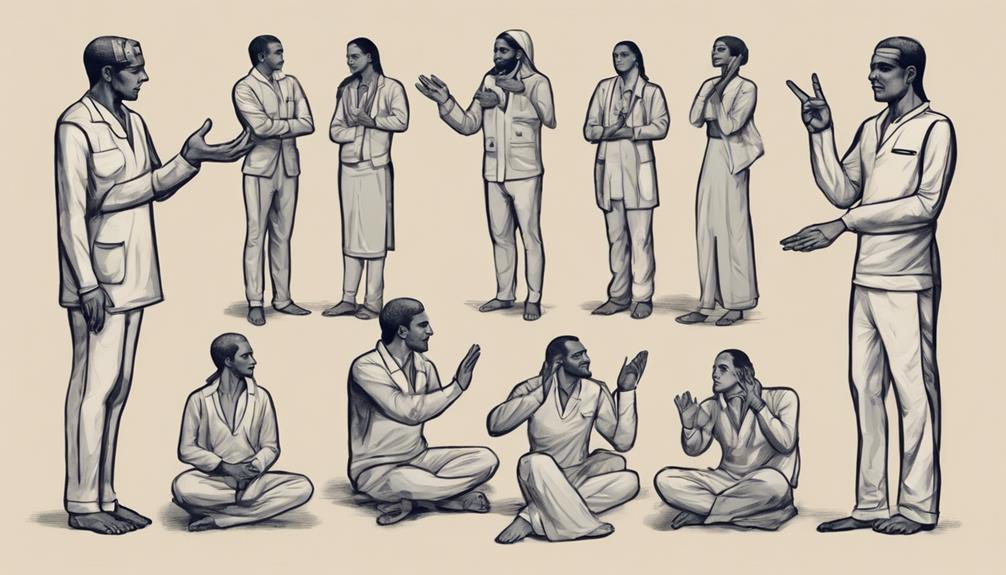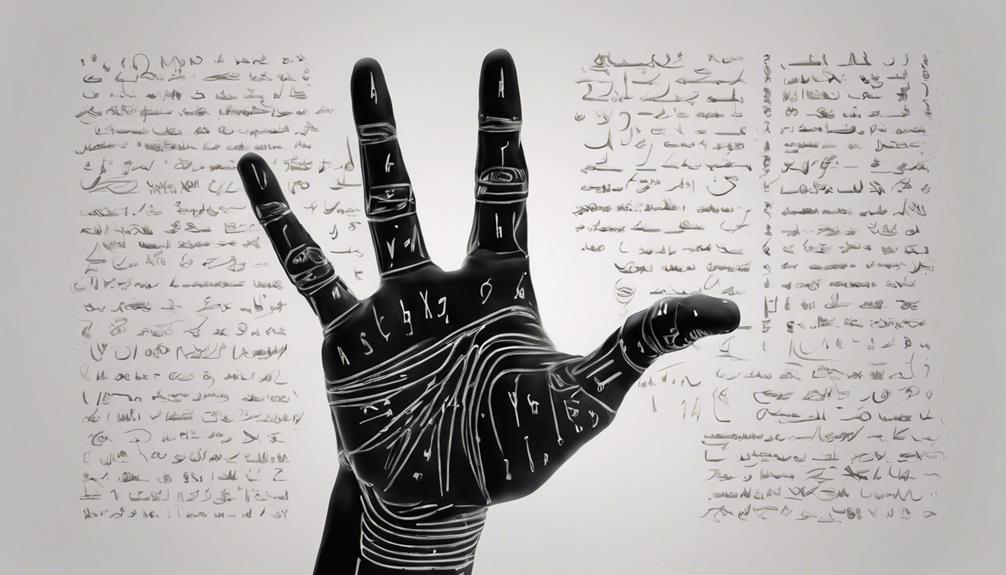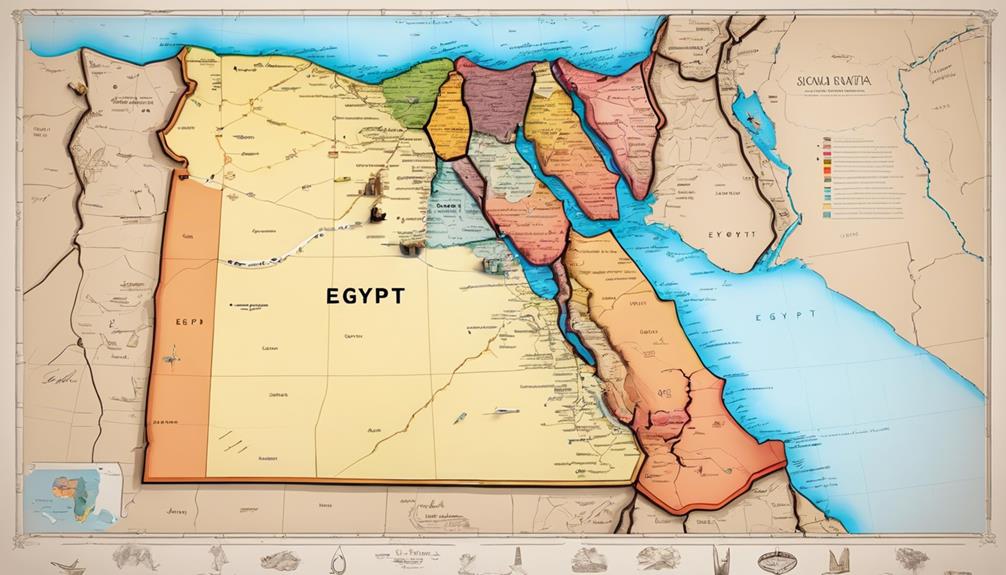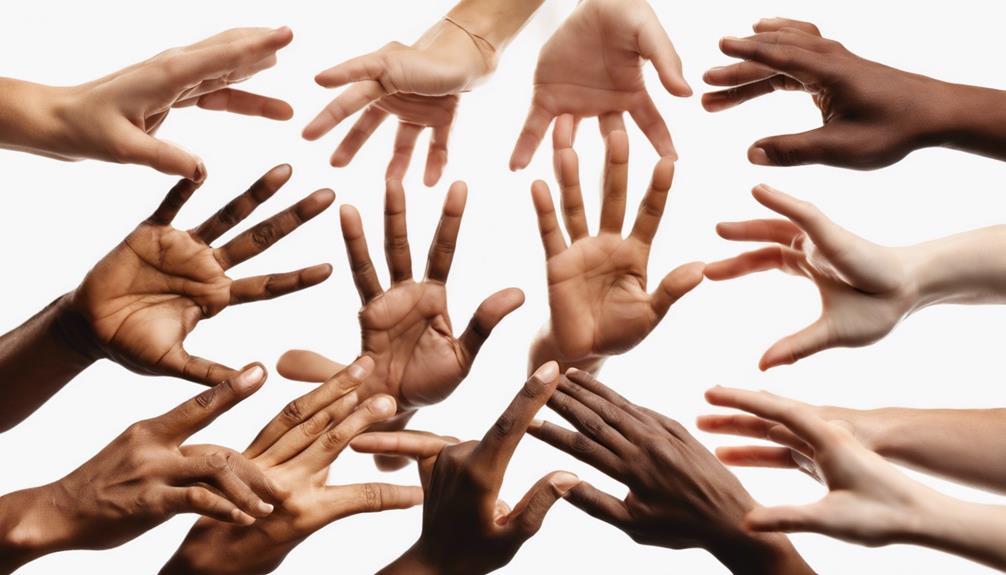Exploring Egyptian Sign Language is like unraveling a complex tapestry; each sign, gesture, and expression we learn adds a new thread to the rich tapestry of communication with the deaf community.
As we navigate through the depths of ESL, uncovering its nuances and significance, we find ourselves on a journey of understanding and connection that transcends words.
Join us on this exploration of mastering Egyptian Sign Language, where cultural insights, practical techniques, and the impact of inclusive communication await discovery.
Key Takeaways
- Understanding the historical roots and influences enhances proficiency and connection.
- Mastering the SOV sentence structure and visual grammar components improves fluency.
- Utilizing common gestures, fingerspelling, and non-manual signals aids communication clarity.
- Adhering to cultural context and etiquette fosters inclusivity and deepens relationships.
Origins of Egyptian Sign Language
The origins of Egyptian Sign Language can be traced back to the early 20th century in Egypt, where it was heavily influenced by French Sign Language during its developmental stages. This influence from French Sign Language laid the groundwork for the structure and vocabulary of Egyptian Sign Language. As Egyptian Sign Language evolved, it incorporated unique cultural references specific to Egypt, enriching its lexicon with local nuances and distinctions that set it apart from other sign languages.
Understanding the historical context of how Egyptian Sign Language came to be is crucial for mastering this language. By recognizing its roots in French Sign Language and its subsequent cultural adaptations, learners can appreciate the depth and complexity of Egyptian Sign Language. This knowledge not only enhances one's proficiency in the language but also fosters a deeper connection to the deaf community in Egypt.
Structure and Grammar

Unveiling the intricate framework of Egyptian Sign Language reveals a structure that intricately weaves together spatial elements, facial expressions, and precise hand movements. Understanding these foundational aspects is crucial for mastering this rich language.
Here are three key elements to consider:
- Subject-Object-Verb (SOV) Sentence Structure: Egyptian Sign Language follows this order, where the subject comes first, followed by the object and then the verb. This structure forms the backbone of constructing meaningful sentences in Egyptian Sign Language.
- Pronouns and Gestures: Pronouns in Egyptian Sign Language aren't just spoken but indicated through specific gestures and locations in the signing space. It's vital to grasp these nuances to accurately convey the intended meaning.
- Verb Tenses and Classifier Handshapes: Verb tenses and aspect markers are portrayed through movement, repetition, and duration in signing. Additionally, classifier handshapes are employed to visually represent objects, locations, or actions in a spatial manner. Mastering these components enhances fluency and clarity in communication.
Common Gestures and Expressions
Exploring the depth of Egyptian Sign Language, one uncovers a myriad of common gestures and expressions that intricately shape communication within the deaf community. These gestures go beyond mere hand movements; they include specific handshapes and movements that effectively convey meaning. From expressing basic emotions to engaging in daily interactions, Egyptian Sign Language offers a rich tapestry of expressions. Deaf individuals rely on these gestures for greetings, farewells, asking questions, and showing gratitude.
Understanding and mastering these common gestures and expressions in Egyptian Sign Language is crucial for fostering effective communication with the deaf community. By learning these fundamental aspects, individuals can actively participate in conversations and interactions, promoting inclusivity and understanding within deaf culture. Moreover, proficiency in these gestures not only facilitates communication but also demonstrates respect for the language and the community it represents.
In essence, mastering the basic gestures and expressions in Egyptian Sign Language paves the way for meaningful connections and a deeper appreciation of deaf culture.
Fingerspelling Techniques

Delving into fingerspelling techniques in Egyptian Sign Language unveils the intricate handshapes that represent each letter of the alphabet, essential for expressing names, places, and other proper nouns. Mastering these techniques is crucial for effective communication within the deaf community.
- Unique Handshapes: Each letter in the Arabic alphabet corresponds to a distinct handshape for fingerspelling, requiring precision and dexterity to convey the intended message accurately.
- Enhanced Communication: Fingerspelling enables deaf individuals to spell out names, locations, and specialized terms, fostering clearer understanding and smoother interactions in both casual conversations and formal settings.
- Vocabulary Building: Proficiency in fingerspelling not only aids in spelling out specific words but also serves as a cornerstone for expanding one's vocabulary and expressing complex ideas in Egyptian Sign Language.
Cultural Context and Etiquette
Understanding the cultural context and etiquette of Egyptian Sign Language is essential for fostering effective communication and building meaningful connections within the deaf community.
In Egyptian Sign Language, etiquette goes beyond just hand movements; it encompasses maintaining eye contact, respecting personal space, and using appropriate facial expressions. These aspects are crucial for conveying respect and understanding in interactions.
Moreover, cultural nuances like body language and gestures significantly influence the meaning conveyed in Egyptian Sign Language. By being attuned to these subtleties, we can enrich our communication and deepen our relationships within the community.
Knowledge of social norms and customs not only facilitates smoother interactions but also promotes inclusivity and harmony. Embracing the rich cultural heritage embedded in Egyptian Sign Language not only enhances our proficiency but also fosters a sense of belonging and mutual appreciation.
Therefore, delving into the cultural context and etiquette of Egyptian Sign Language is a vital step towards mastering this expressive and nuanced form of communication.
Regional Variations and Dialects

When considering Egyptian Sign Language, one must recognize the significance of regional variations and dialects in shaping communication dynamics within the deaf community.
Key Points:
- Regional variations in Egyptian Sign Language encompass differences in vocabulary, grammar, and facial expressions influenced by geographical regions in Egypt.
- Dialectal variations in sign language can impact communication between deaf individuals from different areas within Egypt, highlighting the importance of understanding these nuances for effective interaction.
- Some regional sign language dialects may incorporate local customs, slang, or cultural references unique to specific areas, emphasizing the rich diversity present within Egyptian Sign Language.
Understanding and appreciating these regional differences not only enriches our grasp of Egyptian Sign Language but also fosters inclusivity and empathy within the deaf community. Sign language interpreters, in particular, play a crucial role in bridging these regional gaps to ensure seamless communication across various settings in Egypt.
Sign Language Alphabet

As we move into discussing the Sign Language Alphabet, it's crucial to understand the key components:
Handshape Basics, Finger Spelling, and Non-Manual Signals.
Mastering these elements is fundamental to effectively communicating in Egyptian Sign Language.
Hand movements and positions play a vital role in conveying meaning, especially when fingerspelling proper nouns.
Handshape Basics
Mastering handshapes in Egyptian Sign Language is essential for accurate communication and effective expression within the deaf community.
- Handshapes Represent Letters: Each of the 28 handshapes in Egyptian Sign Language corresponds to a letter in the Arabic alphabet, forming the basis for fingerspelling and conveying proper nouns accurately.
- Distinctiveness for Clarity: The uniqueness of each handshape in the sign language alphabet aids in clear communication and understanding, ensuring that messages are conveyed accurately and precisely.
- Importance of Hand Movements: Hand movements and positions in Egyptian Sign Language are crucial for expressing meaning and context, emphasizing the significance of mastering these foundational elements for effective communication within the deaf community.
Finger Spelling
Finger spelling in Egyptian Sign Language is a vital component of communication, allowing for the representation of each letter of the Arabic alphabet through distinct handshapes. Mastering finger spelling is essential for conveying precise information like names and specialized terms. Each of the 28 handshapes corresponds to a specific letter, enabling the spelling of words and proper nouns accurately. To aid in your learning, here is a table showcasing some of the handshapes used in Egyptian Sign Language finger spelling:
| Handshape | Letter | Example |
|---|---|---|
| A | أ | أحمد |
| B | ب | بسمة |
| C | ت | تامر |
Understanding these handshapes and their corresponding letters is foundational for proficient communication in Egyptian Sign Language.
Non-Manual Signals
Understanding the significance of non-manual signals in Egyptian Sign Language is fundamental for achieving clear and expressive communication within the deaf community.
Key Points:
- Non-manual signals, such as facial expressions and head movements, convey grammatical information crucial for proper sentence structure and meaning.
- These signals play a vital role in indicating various linguistic functions like questions, negation, and emphasis, enriching the depth and clarity of communication.
- Mastering non-manual signals alongside manual signs is essential for the deaf community to establish a complete and nuanced communication system, enabling fluency and effective expression in Egyptian Sign Language conversations.
Facial Expressions and Non-Manual Signals

When we use facial expressions and non-manual signals in Egyptian Sign Language, we're adding layers of meaning to our signs. These gestures help us convey questions, express emotions, and emphasize the tone of our communication.
Understanding and mastering these aspects is fundamental for effective and nuanced expression in sign language.
Importance of Expressions
In Egyptian Sign Language, mastering the use of facial expressions and non-manual signals is crucial for conveying grammatical information and emotional nuances effectively. These elements are fundamental in sign language communication and play a significant role in expressing various aspects of a message.
Here are three key points to consider:
- Grammatical Information: Facial expressions and non-manual signals help differentiate between questions and statements, emphasize intensity, and indicate the emotional tone of the message.
- Emotional Nuances: They're essential for conveying emotions such as happiness, sadness, surprise, and more, adding depth and richness to the communication.
- Enhanced Clarity: Non-manual signals like head movements, eye gaze, facial expressions, and body posture enhance the clarity and meaning of signed messages, aiding in comprehension and fluency. Mastering these aspects is vital for effective communication in Egyptian Sign Language.
Gestures for Questions
Facial expressions and non-manual signals play a pivotal role in Egyptian Sign Language when indicating questions, providing a nuanced form of communication beyond hand gestures. Raised eyebrows are commonly used to signify questions, while non-manual signals like head tilting or leaning forward can also indicate questioning. Eye gaze direction is crucial as it can convey the type of question being asked. Incorporating appropriate body movements further enhances the clarity of questions in sign language. Mastering these non-manual signals is essential for effective communication in Egyptian Sign Language. Below is a table outlining some key gestures for questions in Egyptian Sign Language:
| Gesture | Description | Example |
|---|---|---|
| Raised eyebrows | Indicates a question is being asked | "Where are you going?" |
| Head tilt | Shows curiosity or confusion | "Why did you do that?" |
| Eye gaze direction | Signals the type of question being asked | Looking up for "who", down for "what" |
| Leaning forward | Expresses interest or urgency | "When will you be back?" |
| Body movements | Enhance clarity and emphasis in questioning | Pointing while signing "where" for location questions |
Role of Body Language

Utilizing body language in Egyptian Sign Language is a fundamental aspect that enhances communication by conveying emotions and nuances effectively. Body language in sign language encompasses various elements such as facial expressions, head movements, and body postures, all of which contribute to the richness of the message being conveyed.
Here are three key points highlighting the importance of body language in Egyptian Sign Language:
- Enhanced Clarity: The use of body language in sign language not only adds depth to communication but also enhances the clarity and meaning of the message. Expressions like nodding, shrugging, and eye contact are essential components that aid in conveying the intended message accurately.
- Grammar and Structure: Body language, including gestures and expressions, plays a crucial role in the grammar and structure of Egyptian Sign Language. These non-manual signals help differentiate between questions, statements, and various emotions during sign language conversations.
- Effective Communication: Mastering body language in sign language is indispensable for effective communication and understanding within the deaf community. It fosters a deeper connection and ensures that messages are accurately interpreted, leading to more meaningful interactions.
Resources for Further Learning

Exploring diverse avenues for expanding knowledge and proficiency in Egyptian Sign Language is essential for fostering inclusive communication environments. To further enhance mastery, individuals can utilize a variety of resources tailored to different learning styles. Online platforms offer courses ranging from beginner to advanced levels, providing interactive lessons, videos, and quizzes.
Additionally, joining local deaf communities or attending sign language events can offer real-life practice and cultural insights. Books and dictionaries specific to Egyptian Sign Language can deepen understanding of grammar rules, vocabulary, and regional variations. Seeking mentorship from experienced sign language users or certified interpreters can provide valuable guidance and feedback.
Moreover, workshops and seminars focusing on deaf culture and advocacy can broaden perspectives and enhance communication skills. By engaging with these resources, learners can continuously improve their proficiency in Egyptian Sign Language and contribute to creating more inclusive and accessible spaces for the deaf community in Egypt.
Frequently Asked Questions
Which Sign Language Does Egypt Use?
We use Egyptian Sign Language (EgySL) as our primary means of communication. It's a rich language with a 28-letter alphabet, each letter represented by specific handshapes.
EgySL, born from the early 20th century, has deep cultural roots and is now an official language in Egypt. Its widespread recognition helps bridge communication gaps for the deaf community.
Sign language interpreters play a crucial role in ensuring accessibility in various settings.
How Long Does It Take to Become Proficient in American Sign Language?
It typically takes 2-3 years of regular study and practice to reach intermediate proficiency in American Sign Language (ASL). Becoming fluent, comparable to a native signer, may require 5-7 years of dedicated learning and immersion.
Immersion programs, interaction with the Deaf community, and consistent practice can speed up the process. Mastery also hinges on mastering complex conversations, retaining vocabulary, and accurately conveying nuanced meanings.
How Do You Master Sign Language?
To master sign language, we engage in regular practice, attend classes, watch videos, and seek feedback. By immersing ourselves in conversations, we improve fluency and comprehension.
Workshops help us grasp grammar and vocabulary, while videos and events enhance our skills. Flashcards and mnemonic devices aid in memorization. Feedback from proficient signers guides us in correcting mistakes and refining our abilities.
This holistic approach accelerates our journey to mastery.
What Language Is Spoken in Egypt?
We speak of the languages in Egypt. Arabic is the predominant language, with Egyptian Arabic widely used daily. Coptic, stemming from ancient Egyptian, is employed in religious settings by Coptic Christians.
French and English find use in urban locales and among the educated. Berber languages are spoken by the Berber minority. This linguistic diversity enriches the Egyptian tapestry, offering a wide array of communication avenues.
Conclusion
As we wrap up our journey through 'Mastering Egyptian Sign Language: A Comprehensive Guide', we're like explorers uncovering a hidden treasure trove of communication and connection.
Just as a compass guides us through uncharted territories, this guide navigates us through the rich and diverse world of ESL.
Let's continue to embrace and learn from this unique language, fostering inclusivity and understanding for all members of the deaf community.
Together, we can bridge the gap and build a more accessible and compassionate society.











